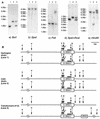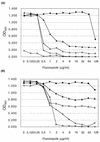Genetic analysis of azole resistance in the Darlington strain of Candida albicans
- PMID: 11036010
- PMCID: PMC101590
- DOI: 10.1128/AAC.44.11.2985-2990.2000
Genetic analysis of azole resistance in the Darlington strain of Candida albicans
Abstract
High-level azole resistance in the Darlington strain of Candida albicans was investigated by gene replacement in C. albicans and expression in Saccharomyces cerevisiae. We sequenced the ERG11 gene, which encodes the sterol C(14)alpha-demethylase, from our copy of the Darlington strain. Both alleles contained the histidine for tyrosine substitution at position 132 (Y132H) reported in Darlington by others, but we also found a threonine-for-isoleucine substitution (I471T) not previously reported in the C. albicans ERG11. The encoded I471T change in amino acids conferred azole resistance when overexpressed alone and increased azole resistance when added to the Y132H amino acid sequence in an S. cerevisiae expression system. Replacement of one copy of ERG11 in an azole-susceptible strain of C. albicans with a single copy of the Darlington ERG11 resulted in expression of the integrated copy and a modest increase in azole resistance. The profound azole resistance of the Darlington strain is the result of multiple mutations.
Figures



Similar articles
-
[Azole resistance in Candida spp].Nihon Ishinkin Gakkai Zasshi. 2003;44(2):87-92. doi: 10.3314/jjmm.44.87. Nihon Ishinkin Gakkai Zasshi. 2003. PMID: 12748589 Review. Japanese.
-
Amino acid substitutions in the cytochrome P-450 lanosterol 14alpha-demethylase (CYP51A1) from azole-resistant Candida albicans clinical isolates contribute to resistance to azole antifungal agents.Antimicrob Agents Chemother. 1998 Feb;42(2):241-53. doi: 10.1128/AAC.42.2.241. Antimicrob Agents Chemother. 1998. PMID: 9527767 Free PMC article.
-
A newly identified amino acid substitution T123I in the 14α-demethylase (Erg11p) of Candida albicans confers azole resistance.FEMS Yeast Res. 2017 May 1;17(3). doi: 10.1093/femsyr/fox012. FEMS Yeast Res. 2017. PMID: 28334124
-
Multiple amino acid substitutions in lanosterol 14alpha-demethylase contribute to azole resistance in Candida albicans.Microbiology (Reading). 1999 Oct;145 ( Pt 10):2715-25. doi: 10.1099/00221287-145-10-2715. Microbiology (Reading). 1999. PMID: 10537193
-
Screening for amino acid substitutions in the Candida albicans Erg11 protein of azole-susceptible and azole-resistant clinical isolates: new substitutions and a review of the literature.Diagn Microbiol Infect Dis. 2010 Apr;66(4):373-84. doi: 10.1016/j.diagmicrobio.2009.11.006. Diagn Microbiol Infect Dis. 2010. PMID: 20226328 Review.
Cited by
-
Inactivation of sterol Delta5,6-desaturase attenuates virulence in Candida albicans.Antimicrob Agents Chemother. 2005 Sep;49(9):3646-51. doi: 10.1128/AAC.49.9.3646-3651.2005. Antimicrob Agents Chemother. 2005. PMID: 16127034 Free PMC article.
-
Structural basis for heterogeneous phenotype of ERG11 dependent Azole resistance in C.albicans clinical isolates.Springerplus. 2014 Nov 6;3:660. doi: 10.1186/2193-1801-3-660. eCollection 2014. Springerplus. 2014. PMID: 25512882 Free PMC article.
-
Candida albicans sterol C-14 reductase, encoded by the ERG24 gene, as a potential antifungal target site.Antimicrob Agents Chemother. 2002 Apr;46(4):947-57. doi: 10.1128/AAC.46.4.947-957.2002. Antimicrob Agents Chemother. 2002. PMID: 11897574 Free PMC article.
-
Amino acid substitutions at the major insertion loop of Candida albicans sterol 14alpha-demethylase are involved in fluconazole resistance.PLoS One. 2011;6(6):e21239. doi: 10.1371/journal.pone.0021239. Epub 2011 Jun 16. PLoS One. 2011. PMID: 21698128 Free PMC article.
-
Limited ERG11 Mutations Identified in Isolates of Candida auris Directly Contribute to Reduced Azole Susceptibility.Antimicrob Agents Chemother. 2018 Sep 24;62(10):e01427-18. doi: 10.1128/AAC.01427-18. Print 2018 Oct. Antimicrob Agents Chemother. 2018. PMID: 30082281 Free PMC article.
References
-
- Favre B, Didmon M, Ryder N S. Multiple amino acid substitutions in lanosterol 14α-demethylase contribute to azole resistance in Candida albicans. Microbiology. 1999;145:2715–2725. - PubMed
-
- Fujimura H, Sakura Y. Simplified isolation of chromosomal and plasmid DNA from yeast. BioTechniques. 1993;14:538–539. - PubMed
Publication types
MeSH terms
Substances
LinkOut - more resources
Full Text Sources
Molecular Biology Databases

